Network
Eero Mesh Wireless Review
03/01/17 16:07 Filed in: Technology

I live in a home with three boys who are all tech savvy like their dad. They love to play online games and stream video at the same time. This takes a big toll on my network and I was having some major issues with slower speeds down by my television which has an Xbox One, AppleTV, Roku, Yamaha Receiver and Panasonic TV connected to an old AirPort Extreme Base Station what was extending my wireless network. Having read about mesh networks and after hearing that Apple was most likely no longer developing their router business, I decided to go on a search for a mesh system that would take care of all of my issues.
I read reviews about the various systems and had narrowed my search down to the Orbi by Netgear which was getting some great reviews for speed and throughput, and the Eero which was highly recommended by Dave Hamilton from the Mac Observer and by David Sparks and Katie Floyd over at the Mac Power Users Podcast. After much research and looking at the options, I decided to go with the Eero due to it's frequent updates, great customer service (which I called before I bought) and it's great configuration app (though it does have an issue which I hope will be resolved in the next update). I was able to get the Eero three pack for $100 off and had some Best Buy gift cards which brought the price down for me. It is the more expensive option at retail so keep that in mind as you research the various solutions.
Unboxing
The Eero's packaging is on par with something you would get from Apple. The nice slide out box with foam padding to protect the top of the Eero's along with the customized cut outs for each Eero that include a cover telling you more about the Eero and a premium looking power cable with an Ethernet cable thrown in really make a great first impression. The whole package screams premium device and does raise your expectations from the start.
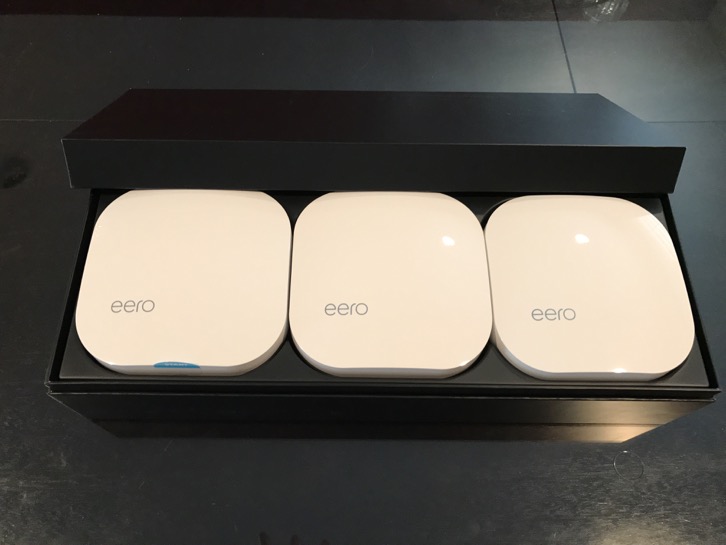
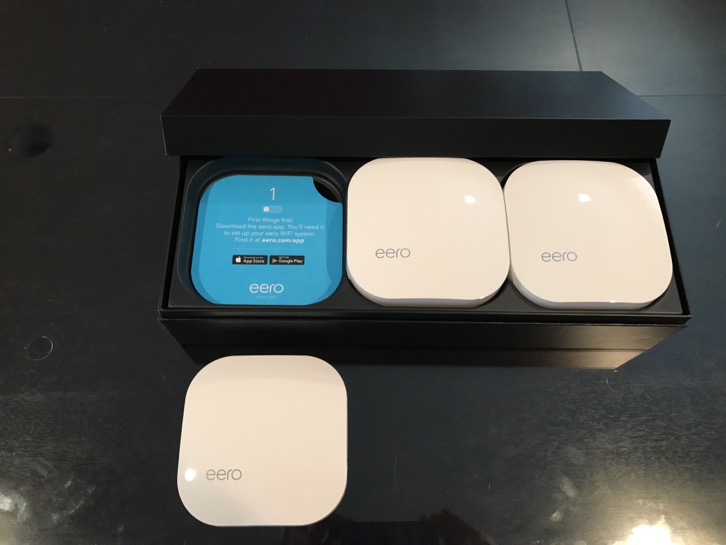
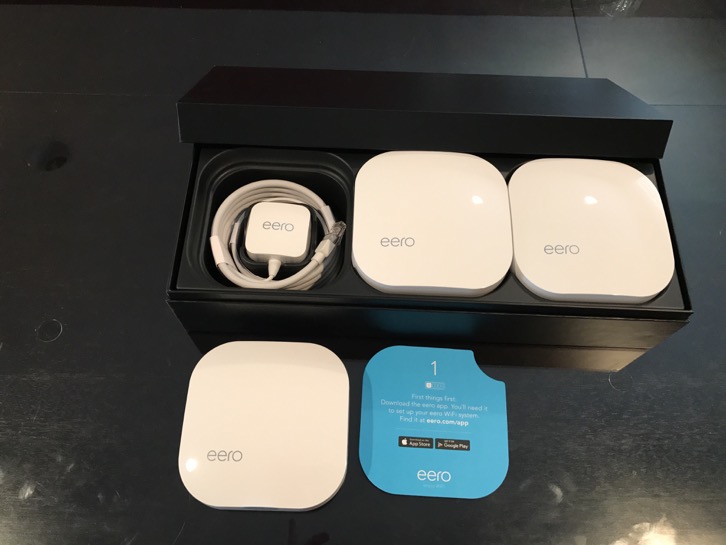
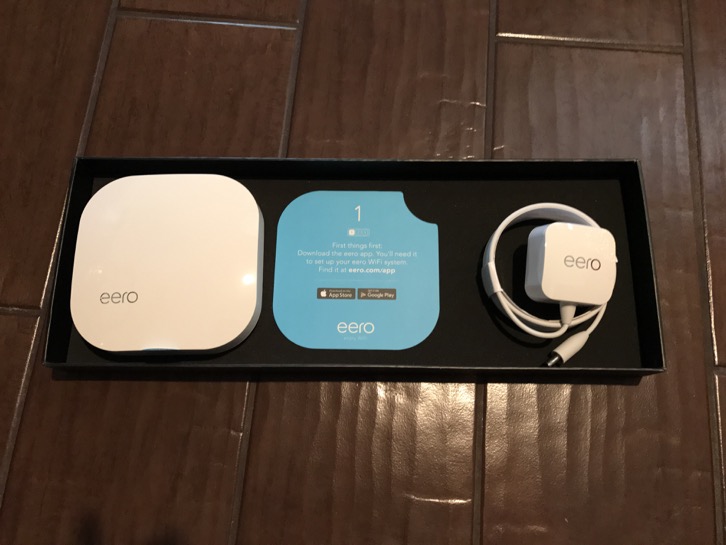
Installation and Set Up
Installation of the Eero's was a snap. You install the application on your iPhone or other device, create a login, verify your login with a code that is texted to you and then follow the onscreen directions to setting up your Eero network. The recommendation is that each Eero is either in line of site or that you limit the obstructions between Eeros to create the best coverage for your network. In my home my modem is on the second floor next to my computer desk on one side of my home. I put an Eero there, plugging in the modem to the Eero. I added a Netgear switch as, one of the disadvantages of the Eeros is that they each only have two ethernet ports. With the switch connected I could add all of my devices on desk but it does add an additional item to have on my desk.
Once the cables were all plugged in, I plugged the modem and the Eero back in and let them boot up. As soon as the devices were booted up, the app located the Eero and started the network set up. It was a breeze to set up my new network and the wizard made it something that my dad could do with little fuss or risk of getting stuck.
Once the network was set up the app asked if I had other Eeros to set up. I plugged the next Eero in downstairs in my front room right below my first Eero. The Eero system uses the location of your device that has the app to automatically locate the second and third Eeros. Once the second Eero booted up the app found it and started configuring it. Once done I was greeted by a screen that said, "Boom! Your Eero is set up." I then went and located the third Eero by myth television where I was having the issues. I went through the same process and got the same result. The app does a good job of helping you know if you are locating the Eero in a place that is optimized for your home. In a set up I did for my dad, we were told a couple of times that our location was not optimal and we were able to move the Eeros to get them to the right spot for them to connect. Having that kind of analysis and help without having to experiment yourself really is a nice feature of the system set up.
I did a video walk through of this set up process if you want to see what each step looked like on my iPhone as I did it. You can view the video below:
Testing My New Eero Network
Once I had everything set up I went to the spot where I was having the most issues and did a speed test. Before my speeds would be half the speeds I would get at my Mac Mini connected directly to the router by ethernet. With the Eeros I was getting just about full speed, I say just about because ethernet still is the fasted speed you can get compared to wireless. I was excited. I noticed that the app would track which Eero I was connected to which was great to see how my devices would automatically switch to the strongest signal which would be the closest Eero.
My speeds were not any faster than before but they were fast in every spot in my home which is what I was after. Another benefit has been almost no drop off's or lags like I experienced with my previous set up. One of the biggest evidence of the change Eero had made came from my boys who do online gaming. They all stated they could tell the difference and they were excited about not having to worry about the bandwidth while playing their online games.
One of the advantages of getting a system like this is the blanketing of your network speeds across your home without having to worry about who is online when. This certainly has been my experience so far and I will continue to test but so far I am impressed.
Managing Your Network with the Eero App
The Eero application is where you do all the work to manage your network. At a glance you get a built in speed test that can be re-run at anytime just by dragging down on the home screen. It also shows each of your Eeros with the status of each. You are also greeted with the number of devices you have on your network and can drill into that list and see how each device is connected, the local IP address, MAC address and a space where you can give each device a nickname to make it easier to identify your network devices.
On the side is a menu that allows for setting up a guest network with a slider and a button that allows you to share the SSID and password with your guests via text or email making it easier to get people on your network without having to repeat your login credentials for each device your family wants to connect.
There is also a Profiles area that allows you to set up different profiles for the devices you want to manage on your network. This comes in handy if you have kids like I do and you can't seem to get them off their devices to get them to dinner or to leave for school. With profiles, I set one up for the kids for instance and add each of their devices to the profile. I then had the ability to turn off network access for all of those devices or set time limits for when access is allowed. This can be done on a device by device basis as well, but it is nice to have a group where you can shut everything down for them at once while still keeping your own access working.
Finally there is an advanced area where you can do most of the things you would need to do for things like running a macOS Server. There is a space for DHCP reservations (which I promptly set up for my server). These reservations are limited to one local range so the 10.0.1.3 that I use in my server tutorials won't work and needs to be changed. There is also a place to set up custom DNS which I also did for my server as the primary DNS entry and OpenDNS for the second one which adds the filtering I use across my network. For port forwarding you do this on a per device basis so I used my server and forwarded the necessary ports needed for my various server services. There is also built in Universal Plug and Play (UPnP) which you can enable or disable as well which allows devices like game consoles to automatically configure the access they need.
Overall most of the settings I am used to using on a frequent basis are present in the Eero app. I do miss the integration of my Apple Router with the macOS Server app where ports are opened automatically. Radius is also not available as it is with the AirPort Extreme Base Station but I wasn't using that myself anyway.
In using the app I stumbled across the fact that I could remotely change ports or configure my server without having to be on my local network. Now that was an advantage on one hand especially where I forgot to forward a needed port while on the road and was able to just open it. On the other hand, this does pose a security issue in that losing your device could potentially lead to someone having control of your network but they would have to have your password to get in. I hope that Eero does implement Touch ID on the app itself instead of just relying on the main login for protection.
To give you an idea of how to each setting looks and work I did another video walk through. You can view that video below:
Conclusion
So far I would say the Eero system has lived up to the hype for me. I was so impressed with my own experience and the simplicity of set up and managing the network that I installed one in my dad's home the follow week while we were visiting as he was having terrible wifi issues. As I experienced in my own home, Eero took care of his issues and he was getting more than double the speeds he had previously in his trouble spots in his home.
So is Eero for you? Or should look into another system? That all depends on your situation and the issues you may be experiencing with your own network set up. If you like to tweak every setting and have more control over your network and router then Eero is not for you. They are rolling out features but so far there are still features missing from other modern routers. If you don't fit that category however, I would seriously consider giving Eero a try!
Comments
Mavericks Server Part 38: Airport Adminstration
21/08/14 07:36 Filed in: Technology
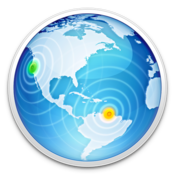
Using the service in OS X Server with an AEBS, Server automatically enters the ports you need for the services you entered. It will also open those ports without the need to restart your router so no one loses internet service and turning services on and off becomes seamless. It really is a great feature of OS X Server and is another reason to consider using an Apple router.
Not only does OS X Server control the opening and closing of ports, it also has a built in RADIUS service. RADIUS stands for Remote Authentication Dial In User Service. This basically means that instead of having your users log onto your wireless network with a general SSID and general password, they log in with their Network Accounts that you set up on your server. So the AEBS is using your Open Directory to determine whether someone is allowed to log onto your network or not. This adds an additional layer of security to your network and is especially useful in organizations where they have users coming and going and those users having the SSID and password necessitates constantly changing the password.
In this screencast I cover how to use the service built into OS X Server to manage your AEBS. I cover how to add new ports to the service for other applications that may need ports opened. I also cover how to set up and use the RADIUS service and talk about an application called Admin Tool Radius that can help you manage multiple RADIUS Networks and manually set up RADIUS if you are not using OS X Server for that service.
If you have any questions or comments feel free to leave them here or on my Youtube Channel.

